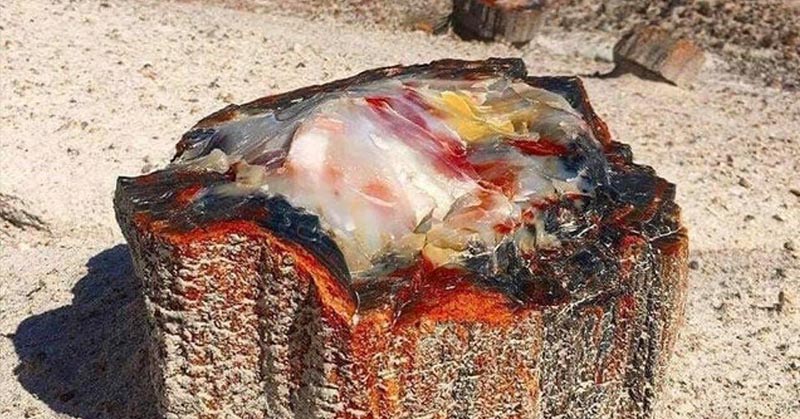Imagine you are walking on your favorite trail or through your local park, when you notice a tree stump that looks different from the rest.
This stump looks like it’s covered in a beautiful rock, maybe even… a precious gem? That can’t be real, can it?
What you are seeing is real and can happen: What you are looking at is opalized wood.
What is opalized wood?
Opalized wood is a type of petrified wood that is made of, you guessed it, opal. Most often it is made of common opal and is therefore still tree-like in look and color. In some rare cases, however, precious opal is formed. When this happens, the tree stump will be covered in the gorgeous, shiny, colorful precious opal. (1, 2)
How is wood opal formed?
Opal forms in the cavities of rocks. In tree stumps, often these cavities are formed because bones, pine cones, rocks, or even small animals are buried into them. Those items eventually become rock and create prime conditions for opal formation. The opal forms a fossilized replica of that object. (1)
In order to form the opalized fossil, silica has to be present. Silica water then fills in whatever gaps there are and hardens, creating opal. There are two types of opalized fossils (1):
- Unpreserved internal details: The silica solution fills in the cavity in the wood and forms an opalized cast of the object that created the cavity in the first place. In this case, the outside is preserved by the inside has long since rotted away.
- Preserved internal details: If somehow the organic material causing the cavity has not rotted, the silica solution can then create a replicated fossil of the internal structure as well. This is what happens with wood or bone.
Forests buried by volcanic ash. This is because the ash not only preserves the items it buries, but it also is a high source of silica. Thanks to volcanic ash there are large concentrations of opalized wood in Brazil, Russia, Indonesia, Mexico, Arizona, Wyoming, and Oregon. (2)
Differences between opalized wood and precious opal
While there can be opalized wood that has turned into precious opal, they are quite rare. In most cases, however, opalized wood does not become precious opal. This means a few things (2):
- It is not highly valuable (if it is precious opal, then it will be.)
- It is less durable.
- It has a lower hardness and is more susceptible to abrasion.
- It has lower tenacity and is likely to break if dropped or put under high stress.
- Less suitable for jewelry and other products.
Whether it’s precious opal or not, opalized wood is still pretty cool to see. If you ever get the chance to see some, take lots of photos! You never know when you will have another opportunity.
Keep Reading: Ancient tree with record of Earth’s magnetic field reversal in its rings discovered

